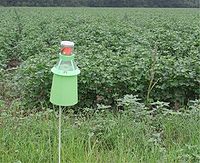
Photo from wikipedia
Abstract Globally, rice production is severely affected by brown planthopper (Nilaparvata lugens) populations. Among the four different biotypes of N. lugens reported worldwide, biotype 4 is the most damaging and… Click to show full abstract
Abstract Globally, rice production is severely affected by brown planthopper (Nilaparvata lugens) populations. Among the four different biotypes of N. lugens reported worldwide, biotype 4 is the most damaging and prevalent insect pest in South East Asian countries, especially in the Indian sub-continent. Management of this pest with resistant genotypes is effective and thus it has received considerable attention worldwide. In the present work, a total of 600 farmer's varieties (FVs) were screened against N. lugens and subsequently 104 panel populations were selected for genotyping. Marker-trait association and genetic diversity were worked out for 87 molecular markers linked to 34 different N. lugens resistance genes. The average content of polymorphism information was 0.354 for 34 genes with a threshold level 0.018 to 0.750. One hundred and four FVs were categorized into three main genetic groups according to cluster analysis and population structure. Resistant and moderately resistant FVs were separately distributed according to principal co-ordinate analysis. Analysis of molecular variance displayed maximum diversity (83%) within population and minimum diversity (17%) between populations. In both generalized linear model (GLM) and multi linear model (MLM), eight markers linked to Bph genes were found to be common for four different phenotypic parameters like honeydew excretion, nymphal survival, percent damage, and feeding mark. Our study suggests that presently available monogenic BPH resistant lines were not withstanding BPH biotype-4 pressure. Thus, the reported resistance genes either alone or in combination could be introgressed into elite varieties with genomic approach to develop robust resistant rice varieties against N. lugens biotype 4. Further, the identified FVs are useful for novel R genes identification, host–insect interaction, and genomic studies.
Journal Title: Crop Protection
Year Published: 2021
Link to full text (if available)
Share on Social Media: Sign Up to like & get
recommendations!